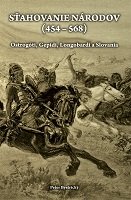Sťahovanie národov (454 - 568). Ostrogóti, Gepidi, Longobardi a Slovania
Migration of Nations (454-568). Ostrogoths, Gepids, Langobards, and Slavs
Author(s): Peter Bystrický
Contributor(s): Jozef Hupka (Editor), Miroslava Čulenová (Editor)
Subject(s): History, Social Sciences, Geography, Regional studies, Sociology, Ancient World, 6th to 12th Centuries, Migration Studies
Published by: SAV - Slovenská akadémia vied - Historický ústav SAV
Keywords: migration; Carpathian basin; Ostrogoths; Gepids; Langobards; Slavs;
Summary/Abstract: The author describes the history of tribes residing in the Carpathian basin after expelling Huns. No one of them remained in Central Europe and all of them, victorious and defeated too, completely or partially, left for Italy. He follows the fates of the kings who came after Attila, but most of them remained in his shade, and tribes that defeated Huns or founded their empires in the territory bounded by the Carpathians, the Alps and the Sava river, but except for one they perished before Avars came to the Danube. East Roman Empire´s interest in Central Europe did not fall even after it ceased to be its part and fought for it with Ostrogoths and Franks. However, it was weakened by its wars against Ostrogoths and Persians and Slavic and Bulgarian incursions. The Migration of peoples was a period, in which the Antiquity perished, and the grounds of Middle Ages were laid. Central Europe, including Slovakia did not remain out of these events, it was more than only its part. The events that took place here after Attila´s Empire break-up, affected development in a large part of Europe. It was instable as not only interests of local kingdoms, but also of the Byzantine Empire, Ostrogoths and later also Franks collided here. Only a year after Attila´s death, seven kingdoms arose here, but 20 years later only four of them remained and after next 15 years there were only two of them, the Kingdom of Herules and the Kingdom of Gepids. Later after next 20 years, Heruls were replaced by Langobards who 60 years later destroyed even the last one. Such a turbulent development was not recorded anywhere in Europe. Although all German tribes that in the followed period resided in the Carpathian Basin, at last as a whole or partially left for Italy, a story of each of them is unique. They were led by nobles, commanders and kings, whose names are not unknown even today. Although the period of the Migration of peoples is perceived particularly as the history of kings and tribes, the retinues of kings and tribal leaders were more important than ever before. It was just the retinues transcending a framework of tribes and families that allowed forming mighty tribe unions since the end of the 2nd century. They were an integrating and stabilizing factor, however, in this period the tribes were eroded by them. Later the retinues, formation and spread of the heavy cavalry allowed arising and developing of vassal relations and together with hardening of a hereditary function of the King, an adoption of Christianity and new social relations opened a way to Middle Ages and feudalism.
- Print-ISBN-13: 978-80-970060-0-6
- Page Count: 201
- Publication Year: 2008
- Language: Slovak
- eBook-PDF
- Sample-PDF
- Table of Content
- Introduction

